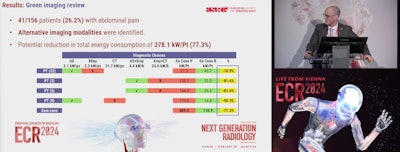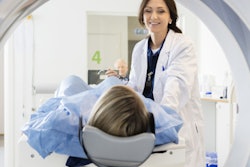Substituting less energy-consuming ultrasound for x-ray or CT reduced energy use by as much as 8% during diagnostic radiology processes and 31.2% during indirect radiology department activities, according to findings of a pilot study presented on 1 March at ECR 2024.
The green project conducted by radiographers at the European Institute of Oncology in Milan and nearby Hospital of Legnano saved an estimated €12,000, said Andrea Masperi, who presented the details. Masperi and colleagues conducted the study between January 2023 and June 2023.
"Despite a few studies on this specific subject, it has emerged that the environmental impact of hospital radiology is not only influenced by the use of large equipment but also by the different elements involved in the whole process of radiology," Masperi said in the talk. "The purpose of this study was to estimate the energy impact in the radiology department and implement a sustainable solution in a testing period and evaluate the impact."
As it has been noted in previous radiology department energy research, substantial amounts of energy are spent when scanners are in an idle state. Masperi and colleagues monitored each unit of power use with radiology equipment on, on standby, and off, then determined the amount of energy consumption for each state; they calculated analysis mapped activities and energy consumption of IFCs and CFCs for daytime x-ray, MRI, and CT. Energy consumption based on the average power declared by the equipment manufacturers and the duration of both active and inactive periods. The team considered unit were considered inefficient if the idle consumption exceeded over 30% of the total consumption.
 Andrea Masperi of the European Institute of Oncology in Milan presented findings of a green radiology pilot study for sustainable radiology at ECR 2024.
Andrea Masperi of the European Institute of Oncology in Milan presented findings of a green radiology pilot study for sustainable radiology at ECR 2024.
The project's first stage involved a review of the radiology department and the categorization of departmental functional units into imaging function categories (IFCs) directly contributing to the diagnostic process, such as CT and MRI, and complementary function categories (CFCs) that indirectly affect energy consumption, such as the reporting workstation. Stage two consisted of a retrospective review of exams performed and their timing.
The study included four interventions:
- Diagnostics activities for critical IFCs were reallocated by redistributing exams during fixed days or by scheduling patients differently by locating slots per patient instead of per anatomical region.
- Consumption was optimized for critical CFCs in relation to activity and idle times, and on and off phases.
- The group developed a "green imaging review" for patients accessing the emergency room.
- The green pilot program included training staff and developing an "energy scorecard."
During the test period between May and July 2023, the team implemented the program and monitored critical IFCs and CFCs for energy consumption as well as the impact of the green imaging review. First results showed a reduction of 8% for IFCs and a reduction of 31.2% for total CFCs, while demonstrating an increase in diagnostic activity of 11.8%, Masperi said.
The green review retrospectively analyzed radiological examinations of 41 of 156 patients with abdominal pain for which the radiology department was able to reduce energy consumption using alternative imaging modalities -- primarily substituting ultrasound for standard imaging such as x-ray or CT -- by 378.1 kilowatts per patient, Masperi said.
"Identifying inefficiencies and noncompliant devices (with European energy guidelines) is possible, so involving radiographers and energy reports could save energy, money, and assist in quality," Masperi concluded, suggesting future research use manufacturers' environmental declarations to assess CO2 emissions.




















